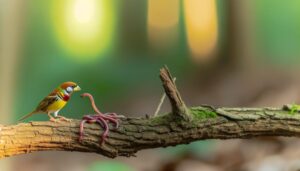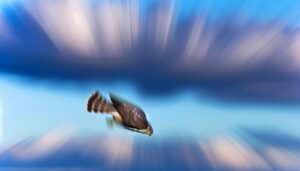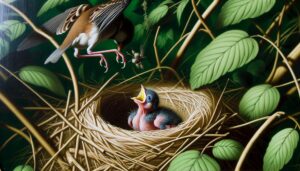From Nest to Sky: How Long After Hatching Do Sparrows Fly?
Sparrow chicks typically fledge, or take their first flight, between 10 and 14 days post-hatch. Newly hatched sparrows, weighing approximately 1.5 grams and measuring about 20 millimeters, undergo rapid growth supported by parental care and regurgitated feedings.
Feather formation is essential, with pin feathers starting early and maturing to support flight. Muscle development, particularly of the pectoralis major and supracoracoideus, is crucial and intensifies around day 7.
Environmental factors such as ambient temperature and food availability further influence developmental milestones. Subsequent sections will elucidate the intricate progressions leading up to this remarkable avian milestone.
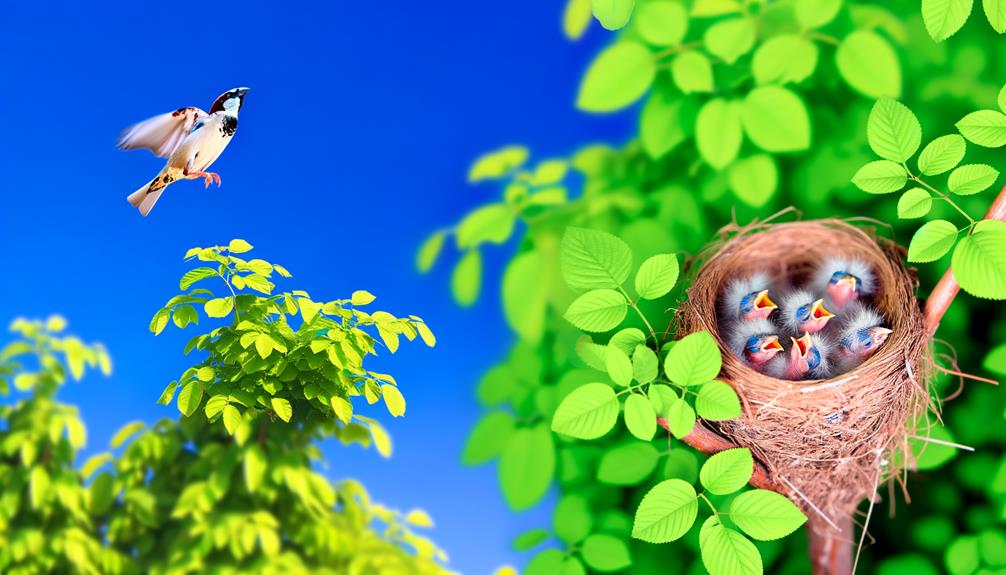
Key Takeaways
- Sparrows typically fledge and are capable of flight within 10-14 days post-hatching.
- Feather maturation, crucial for flight, usually occurs by day 10-14.
- Flight muscle development and coordination are sufficient around the second week post-hatching.
- Ideal conditions like moderate temperatures and abundant food can accelerate readiness for flight.
- Nestlings achieve approximately 80% of adult mass, necessary for flight, by around 15 days.
Hatching and Early Days
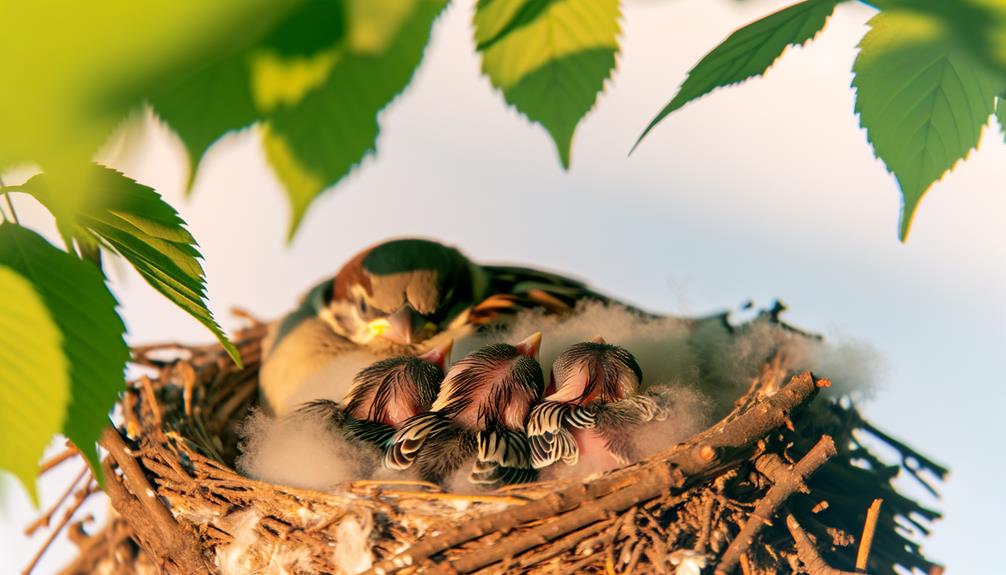
Upon hatching, sparrow chicks are altricial, meaning they are born blind, featherless, and entirely dependent on parental care for survival. These newly hatched chicks typically weigh approximately 1.5 grams and measure about 20 millimeters in length.
The absence of thermoregulatory abilities necessitates constant brooding by the parents to maintain an ideal temperature of around 35°C. The ocular development is nascent, with eyes remaining closed for the initial days post-hatching. Feather development is also in its early stages, characterized by the presence of pin feathers that will gradually unfurl.
Nutritional sustenance is provided exclusively through regurgitated food from the parents, necessitating frequent feeding intervals, averaging every 15-20 minutes during daylight hours. This period represents the most critical phase for chick survival.
Nestling Stage Explained
During the nestling stage, sparrows undergo rapid growth and significant physiological changes. Body mass increases approximately tenfold over a span of two weeks. Parental care is essential during this period. Adult sparrows provide continuous feeding and protection to guarantee ideal development.
Concurrently, feather formation progresses. Primary and secondary feathers emerge, which are necessary for the fledgling's initial flight capabilities.
Growth and Development
Entering the nestling stage, sparrows exhibit rapid physiological and behavioral transformations necessary for their development towards fledging.
During this period, typically spanning 10 to 14 days post-hatching, nestlings undergo significant growth. Body mass increases exponentially, with weight nearly tripling from approximately 2 grams at hatching to around 6 grams by the end of the stage.
Feather development is marked by the emergence of pin feathers, which gradually unfurl into functional feathers essential for thermoregulation and flight. Concurrently, muscle growth, particularly in the pectoral region, strengthens, preparing them for future flight.
Behavioral advancements include enhanced vocalizations, begging behaviors for feeding, and increased motor coordination, all of which are crucial for eventual independence from the nest.
Parental Care
Parental investment during the nestling stage is characterized by meticulous provisioning and protection behaviors, ensuring the nestlings receive adequate nutrition and safety crucial for their continued development.
Adult sparrows engage in frequent foraging, delivering a diverse diet of insects and seeds every 15-20 minutes. This consistent feeding regimen is essential, as nestlings exhibit rapid growth, increasing their body mass approximately 10-fold within the first 10 days post-hatching.
Additionally, parental vigilance is paramount; adult sparrows maintain a close watch to deter predators and regulate nest hygiene by removing fecal sacs.
Such behaviors not only optimize the nestlings' physical development but also enhance their survival prospects, preparing them for subsequent stages of life, including independent flight and self-sustenance.
Feather Formation
Feather development in sparrow nestlings commences rapidly post-hatching, characterized by the emergence of down feathers within the first few days, providing essential insulation and protection.
By approximately day 5, pin feathers start to form, marking the onset of contour feather development. These pin feathers, initially encased in keratin sheaths, gradually elongate and unfurl by day 10 to 12, revealing the juvenile plumage necessary for future flight.
Throughout this stage, the growth rate is meticulously regulated, with protein and calcium intake being critical for best feather formation.
Feather Development
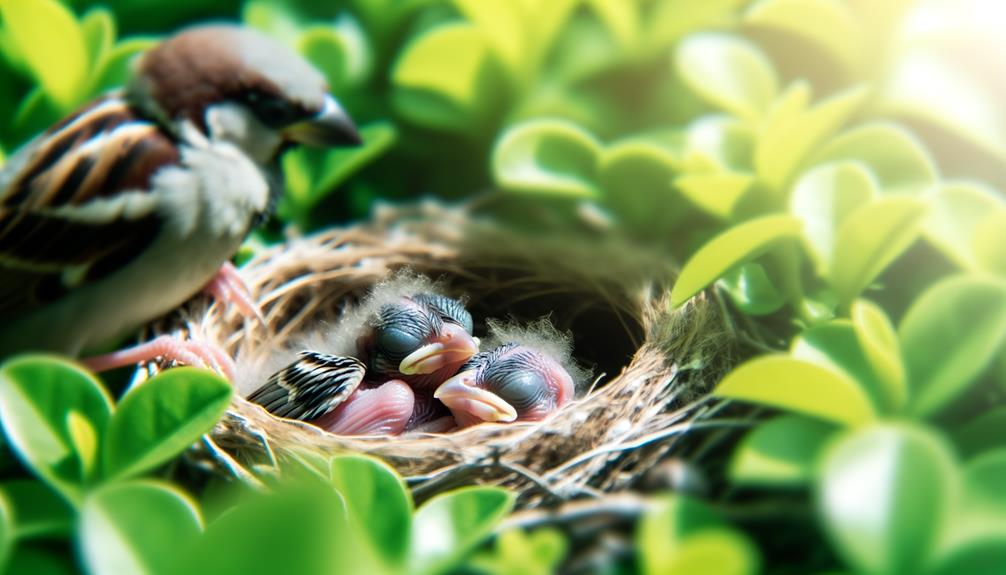
Around the fourth day post-hatching, sparrow chicks begin developing their primary and secondary feathers, a critical stage in their growth towards achieving flight. This feather development is meticulously documented through several stages:
- Pin Feather Emergence: By day 4, pin feathers start to protrude from the skin, marking the initial phase of feather formation.
- Feather Sheath Growth: Between days 5 and 10, the protective sheaths elongate, providing a scaffold for feather maturation.
- Sheath Shedding: By approximately day 10, the sheaths begin to break down, revealing the nascent feathers underneath.
- Feather Unfurling: Over the next week, feathers unfurl and harden, attaining full structural integrity by day 16.
These stages are essential for ensuring the aerodynamic efficiency and insulation necessary for eventual flight.
Strengthening Muscles
The development of flight muscles in sparrow chicks is a vital phase that begins around day 7 post-hatching, characterized by rapid gains in muscle mass and strength.
During this period, the pectoralis major and supracoracoideus muscles, essential for flight, exhibit significant hypertrophy. Detailed observations reveal that muscle fibers increase in diameter by approximately 15% daily, facilitated by enhanced protein synthesis and cellular differentiation.
Concurrently, mitochondria density within these muscles surges, optimizing aerobic capacity for sustained flight. Quantitative measurements indicate that by day 14, muscle mass has doubled compared to initial post-hatch values.
This physiological progression is essential for the chicks' eventual capability to sustain wing beats necessary for flight, laying the groundwork for subsequent stages of avian development.
First Attempts at Flight
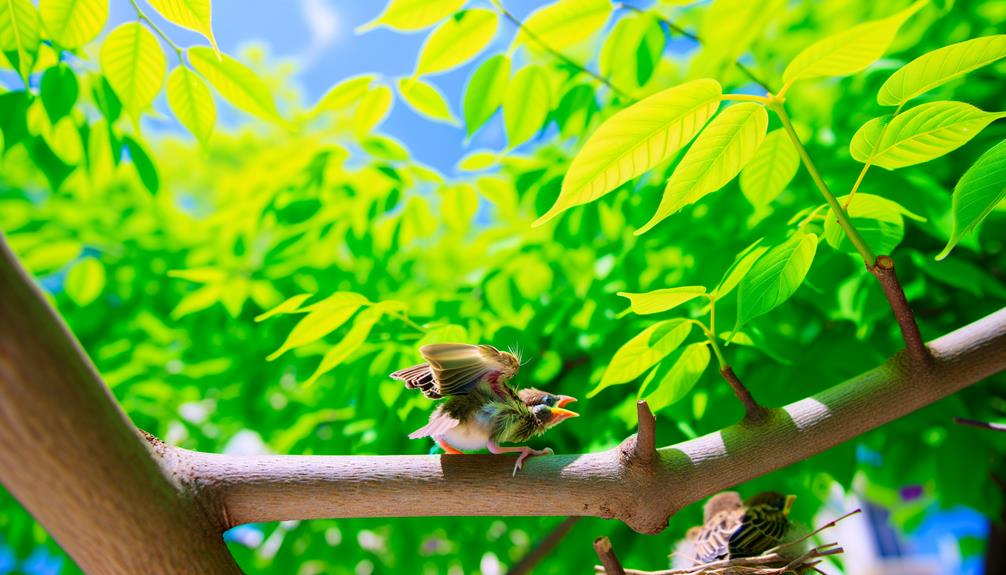
During their initial attempts at flight, sparrow fledglings exhibit a rapid increase in wing flapping. This is essential for building wing strength. Observations indicate that fledglings receive continuous parental guidance. This guidance is critical for directing and controlling their early flights.
Typically, sparrows begin these flight attempts approximately 14 to 17 days post-hatching. This highlights the importance of both physiological and behavioral development during this period.
Building Wing Strength
Prior to achieving sustained flight, sparrow fledglings engage in a series of wing-flapping exercises, which typically commence around day 10 post-hatching, to progressively build the necessary musculature and coordination.
These preparatory activities are critical for the development of flight capability and involve several key stages:
- Initial Wing Flaps: Fledglings initiate weak, sporadic wing movements, lasting mere seconds.
- Increased Frequency: By day 14, wing-flapping episodes increase in frequency and duration, reaching 15-20 seconds.
- Muscle Hypertrophy: Progressive strength gains occur, as pectoral muscles undergo hypertrophy.
- Balance and Coordination: By day 16, fledglings exhibit improved balance and more coordinated flapping, essential for controlled takeoff and landing.
These systematic exercises guarantee fledglings develop the requisite wing strength for eventual independent flight.
Parental Guidance Needed
Parental guidance becomes critical as fledglings make their initial flight attempts around day 14-16 post-hatching, providing both physical support and behavioral cues essential for successful flight initiation.
During this period, parent sparrows engage in demonstrative flights, modeling proper wing movements and safe landing techniques. Observations indicate that fledglings are encouraged through vocalizations and food rewards, reinforcing positive flight behaviors.
Measurements show that the average distance of a fledgling's first flight ranges between 2-5 meters. Parental involvement also includes protecting fledglings from predators and environmental hazards, allowing them to focus on mastering flight mechanics.
Continuous monitoring and gradual reduction of support help fledglings develop the necessary confidence and skill for independent flight.
Environmental Influences
Environmental factors significantly influence the timeline of a sparrow's fledging process. Observational studies show that variations in temperature, food availability, predation risks, and habitat quality affect developmental milestones.
Temperature: Ideal ambient temperatures (20-25°C) accelerate growth, but extremes can delay feather development and muscle coordination.
Food Availability: Abundant food sources ensure rapid weight gain and muscle strength, crucial for fledging, typically occurring within 10-14 days post-hatching.
Predation Risks: High predation pressure can lead to earlier fledging as a survival strategy, especially in environments with increased predator presence.
Habitat Quality: Rich, diverse habitats offer better shelter and foraging opportunities, contributing to healthier, quicker-developing fledglings.
These factors collectively determine when a sparrow is capable of flying.
Signs of Readiness
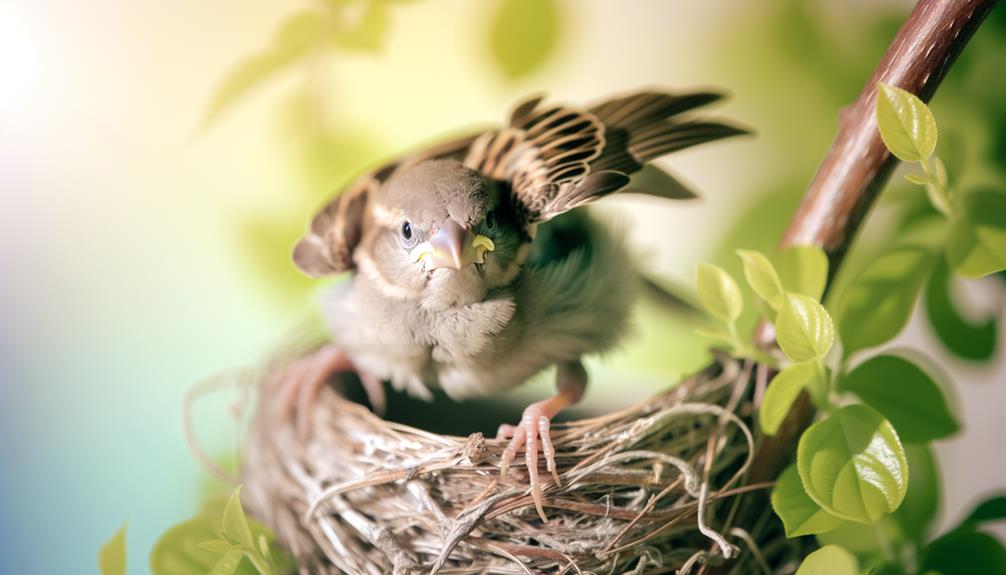
Observing the signs of readiness in sparrows involves monitoring specific developmental milestones such as feather maturation, weight benchmarks, and muscle coordination, which signal the imminent ability to fly.
Feather maturation is evident when primary and secondary feathers exhibit full extension and robust structure, typically around 10-14 days post-hatching.
Weight benchmarks, essential for flight capability, are met when nestlings achieve approximately 80% of adult mass, often around 15 grams.
Muscle coordination is assessed through wing-flapping behaviors and perch stability, indicating neuromuscular readiness.
These indicators are vital for determining the best fledging period, ensuring young sparrows possess the necessary physical attributes for successful flight.
Consistent observation and precise measurement of these milestones provide valuable insights into avian development.
Conclusion
Sparrows typically achieve fledging approximately 14 to 17 days post-hatching, depending on several developmental factors. Feather maturation, muscle fortification, and environmental conditions play pivotal roles in this process.
Observational data indicate that nestlings exhibit initial flight attempts as their physical readiness becomes apparent. The process is akin to a well-oiled machine, where each component must function at its best for successful fledging.
Therefore, understanding these intricate developmental stages is necessary for comprehending the precise timing of a sparrow's first flight.

